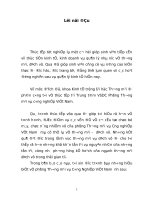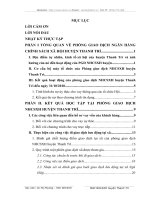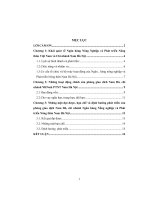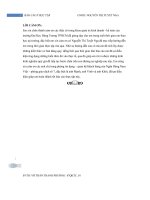BÁO CÁO THỰC TẬP MÔ PHỎNG WIFI
Bạn đang xem bản rút gọn của tài liệu. Xem và tải ngay bản đầy đủ của tài liệu tại đây (769.92 KB, 57 trang )
MATLAB Simulation
Frequency Diversity: Wide-Band Signals
Simulation of Wireless Communication
Systems using MATLAB
Dr. B P. Paris
Dept. Electrical and Comp. Engineering
George Mason University
Fall 2007
Paris ECE 732 1
MATLAB Simulation
Frequency Diversity: Wide-Band Signals
Discrete-Time Equivalent System
Digital Matched Filter and Slicer
Monte Carlo Simulation
Outline
MATLAB Simulation
Frequency Diversity: Wide-Band Signals
Paris ECE 732 2
MATLAB Simulation
Frequency Diversity: Wide-Band Signals
Discrete-Time Equivalent System
Digital Matched Filter and Slicer
Monte Carlo Simulation
MATLAB Simulation
Objective: Simulate a simple communication system and
estimate bit error rate.
System Characteristics:
BPSK modulation, b ∈ {1, −1} with equal a priori
probabilities,
Raised cosine pulses,
AWGN channel,
oversampled integrate-and-dump receiver front-end,
digital matched filter.
Measure: Bit-error rate as a function of E
s
/N
0
and
oversampling rate.
Paris ECE 732 3
MATLAB Simulation
Frequency Diversity: Wide-Band Signals
Discrete-Time Equivalent System
Digital Matched Filter and Slicer
Monte Carlo Simulation
System to be Simulated
× p(t)
∑
δ(t − nT)
×
A
h(t) +
N(t)
Π
T
s
(t)
Sampler,
rate f
s
to
DSP
b
n
s(t ) R(t) R[n]
Figure: Baseband Equivalent System to be Simulated.
Paris ECE 732 4
MATLAB Simulation
Frequency Diversity: Wide-Band Signals
Discrete-Time Equivalent System
Digital Matched Filter and Slicer
Monte Carlo Simulation
From Continuous to Discrete Time
The system in the preceding diagram cannot be simulated
immediately.
Main problem: Most of the signals are continuous-time
signals and cannot be represented in MATLAB.
Possible Remedies:
1. Rely on Sampling Theorem and work with sampled
versions of signals.
2. Consider discrete-time equivalent system.
The second alternative is preferred and will be pursued
below.
Paris ECE 732 5
MATLAB Simulation
Frequency Diversity: Wide-Band Signals
Discrete-Time Equivalent System
Digital Matched Filter and Slicer
Monte Carlo Simulation
Towards the Discrete-Time Equivalent System
The shaded portion of the system has a discrete-time input
and a discrete-time output.
Can be considered as a discrete-time system.
Minor problem: input and output operate at different rates.
× p(t)
∑
δ(t − nT)
×
A
h(t) +
N(t)
Π
T
s
(t)
Sampler,
rate f
s
to
DSP
b
n
s(t ) R(t) R[n]
Paris ECE 732 6
MATLAB Simulation
Frequency Diversity: Wide-Band Signals
Discrete-Time Equivalent System
Digital Matched Filter and Slicer
Monte Carlo Simulation
Discrete-Time Equivalent System
The discrete-time equivalent system
is equivalent to the original system, and
contains only discrete-time signals and components.
Input signal is up-sampled by factor f
s
T to make input and
output rates equal.
Insert f
s
T − 1 zeros between input samples.
×
A
↑ f
s
T
h[n] +
N[n]
to DSP
b
n
R[n]
Paris ECE 732 7
MATLAB Simulation
Frequency Diversity: Wide-Band Signals
Discrete-Time Equivalent System
Digital Matched Filter and Slicer
Monte Carlo Simulation
Components of Discrete-Time Equivalent System
Question: What is the relationship between the
components of the original and discrete-time equivalent
system?
× p(t)
∑
δ(t − nT)
×
A
h(t) +
N(t)
Π
T
s
(t)
Sampler,
rate f
s
to
DSP
b
n
s(t ) R(t) R[n]
Paris ECE 732 8
MATLAB Simulation
Frequency Diversity: Wide-Band Signals
Discrete-Time Equivalent System
Digital Matched Filter and Slicer
Monte Carlo Simulation
Discrete-time Equivalent Impulse Response
To determine the impulse response h[n] of the
discrete-time equivalent system:
Set noise signal N
t
to zero,
set input signal b
n
to unit impulse signal δ[n],
output signal is impulse response h[n].
Procedure yields:
h[n] =
1
T
s
(n+1)T
s
nT
s
p(t) ∗ h(t) dt
For high sampling rates (f
s
T 1), the impulse response is
closely approximated by sampling p(t) ∗ h(t):
h[n] ≈ p(t) ∗ h(t)|
(n+
1
2
)T
s
Paris ECE 732 9
MATLAB Simulation
Frequency Diversity: Wide-Band Signals
Discrete-Time Equivalent System
Digital Matched Filter and Slicer
Monte Carlo Simulation
Discrete-time Equivalent Impulse Response
0 0.2 0.4 0.6 0.8 1
0
0.5
1
1.5
2
Time/T
Figure: Discrete-time Equivalent Impulse Response (f
s
T = 8)
Paris ECE 732 10
MATLAB Simulation
Frequency Diversity: Wide-Band Signals
Discrete-Time Equivalent System
Digital Matched Filter and Slicer
Monte Carlo Simulation
Discrete-Time Equivalent Noise
To determine the properties of the additive noise N[n] in
the discrete-time equivalent system,
Set input signal to zero,
let continuous-time noise be complex, white, Gaussian with
power spectral density N
0
,
output signal is discrete-time equivalent noise.
Procedure yields: The noise samples N[n]
are independent, complex Gaussian random variables, with
zero mean, and
variance equal to N
0
/T
s
.
Paris ECE 732 11
MATLAB Simulation
Frequency Diversity: Wide-Band Signals
Discrete-Time Equivalent System
Digital Matched Filter and Slicer
Monte Carlo Simulation
Received Symbol Energy
The last entity we will need from the continuous-time
system is the received energy per symbol E
s
.
Note that E
s
is controlled by adjusting the gain A at the
transmitter.
To determine E
s
,
Set noise N(t) to zero,
Transmit a single symbol b
n
,
Compute the energy of the received signal R(t).
Procedure yields:
E
s
= σ
2
s
· A
2
|p(t) ∗ h(t)|
2
dt
Here, σ
2
s
denotes the variance of the source. For BPSK,
σ
2
s
= 1.
For the system under consideration, E
s
= A
2
T .
Paris ECE 732 12
MATLAB Simulation
Frequency Diversity: Wide-Band Signals
Discrete-Time Equivalent System
Digital Matched Filter and Slicer
Monte Carlo Simulation
Simulating Transmission of Symbols
We are now in position to simulate the transmission of a
sequence of symbols.
The MATLAB functions previously introduced will be used
for that purpose.
We proceed in three steps:
1. Establish parameters describing the system,
By parameterizing the simulation, other scenarios are easily
accommodated.
2. Simulate discrete-time equivalent system,
3. Collect statistics from repeated simulation.
Paris ECE 732 13
MATLAB Simulation
Frequency Diversity: Wide-Band Signals
Discrete-Time Equivalent System
Digital Matched Filter and Slicer
Monte Carlo Simulation
Listing : SimpleSetParameters.m
3 % This script sets a structure named Parameters to be used by
% the system simulator.
%% Parameters
% construct structure of parameters to be passed to system simulator
8 % communications parameters
Parameters.T = 1/10000; % symbol period
Parameters.fsT = 8; % samples per symbol
Parameters.Es = 1; % normalize received symbol energy to 1 (0dB)
Parameters.EsOverN0 = 6; % Signal-to-noise ratio (Es/N0)
13 Parameters.Alphabet = [1 -1]; % BPSK
Parameters.NSymbols = 1000; % number of Symbols
% discrete-time equivalent impulse response (raised cosine pulse)
fsT = Parameters.fsT;
18 tts = ( (0:fsT-1) + 1/2 )/fsT;
Parameters.hh = sqrt(2/3)
*
( 1 - cos(2
*
pi
*
tts)
*
sin(pi/fsT)/(pi/fsT));
Paris ECE 732 14
MATLAB Simulation
Frequency Diversity: Wide-Band Signals
Discrete-Time Equivalent System
Digital Matched Filter and Slicer
Monte Carlo Simulation
Simulating the Discrete-Time Equivalent System
The actual system simulation is carried out in MATLAB
function MCSimple which has the function signature below.
The parameters set in the controlling script are passed as
inputs.
The body of the function simulates the transmission of the
signal and subsequent demodulation.
The number of incorrect decisions is determined and
returned.
function [NumErrors, ResultsStruct] = MCSimple( ParametersStruct )
Paris ECE 732 15
MATLAB Simulation
Frequency Diversity: Wide-Band Signals
Discrete-Time Equivalent System
Digital Matched Filter and Slicer
Monte Carlo Simulation
Simulating the Discrete-Time Equivalent System
The simulation of the discrete-time equivalent system uses
toolbox functions RandomSymbols, LinearModulation, and
addNoise.
A = sqrt(Es/T); % transmitter gain
N0 = Es/EsOverN0; % noise PSD (complex noise)
NoiseVar = N0/T
*
fsT; % corresponding noise variance N0/Ts
Scale = A
*
hh
*
hh’; % gain through signal chain
34
%% simulate discrete-time equivalent system
% transmitter and channel via toolbox functions
Symbols = RandomSymbols( NSymbols, Alphabet, Priors );
Signal = A
*
LinearModulation( Symbols, hh, fsT );
39 if ( isreal(Signal) )
Signal = complex(Signal);% ensure Signal is complex-valued
end
Received = addNoise( Signal, NoiseVar );
Paris ECE 732 16
MATLAB Simulation
Frequency Diversity: Wide-Band Signals
Discrete-Time Equivalent System
Digital Matched Filter and Slicer
Monte Carlo Simulation
Digital Matched Filter
The vector Received contains the noisy output samples from
the analog front-end.
In a real system, these samples would be processed by
digital hardware to recover the transmitted bits.
Such digital hardware may be an ASIC, FPGA, or DSP chip.
The first function performed there is digital matched
filtering.
This is a discrete-time implementation of the matched filter
discussed before.
The matched filter is the best possible processor for
enhancing the signal-to-noise ratio of the received signal.
Paris ECE 732 17
MATLAB Simulation
Frequency Diversity: Wide-Band Signals
Discrete-Time Equivalent System
Digital Matched Filter and Slicer
Monte Carlo Simulation
Digital Matched Filter
In our simulator, the vector Received is passed through a
discrete-time matched filter and down-sampled to the
symbol rate.
The impulse response of the matched filter is the conjugate
complex of the time-reversed, discrete-time channel
response h[n].
h
∗
[−n]
↓ f
s
T
Slicer
R[n]
ˆ
b
n
Paris ECE 732 18
MATLAB Simulation
Frequency Diversity: Wide-Band Signals
Discrete-Time Equivalent System
Digital Matched Filter and Slicer
Monte Carlo Simulation
MATLAB Code for Digital Matched Filter
The signature line for the MATLAB function implementing
the matched filter is:
function MFOut = DMF( Received, Pulse, fsT )
The body of the function is a direct implementation of the
structure in the block diagram above.
% convolve received signal with conjugate complex of
% time-reversed pulse (matched filter)
Temp = conv( Received, conj( fliplr(Pulse) ) );
21
% down sample, at the end of each pulse period
MFOut = Temp( length(Pulse) : fsT : end );
Paris ECE 732 19
MATLAB Simulation
Frequency Diversity: Wide-Band Signals
Discrete-Time Equivalent System
Digital Matched Filter and Slicer
Monte Carlo Simulation
DMF Input and Output Signal
0 1 2 3 4 5 6 7 8 9 10
−400
−200
0
200
400
Time (1/T)
DMF Input
0 1 2 3 4 5 6 7 8 9 10
−1000
−500
0
500
1000
1500
Time (1/T)
DMF Output
Paris ECE 732 20
MATLAB Simulation
Frequency Diversity: Wide-Band Signals
Discrete-Time Equivalent System
Digital Matched Filter and Slicer
Monte Carlo Simulation
IQ-Scatter Plot of DMF Input and Output
−800 −600 −400 −200 0 200 400 600 800
−200
−100
0
100
200
300
Real Part
Imag. Part
DMF Input
−2000 −1500 −1000 −500 0 500 1000 1500 2000
−500
0
500
Real Part
Imag. Part
DMF Output
Paris ECE 732 21
MATLAB Simulation
Frequency Diversity: Wide-Band Signals
Discrete-Time Equivalent System
Digital Matched Filter and Slicer
Monte Carlo Simulation
Slicer
The final operation to be performed by the receiver is
deciding which symbol was transmitted.
This function is performed by the slicer.
The operation of the slicer is best understood in terms of
the IQ-scatter plot on the previous slide.
The red circles in the plot indicate the noise-free signal
locations for each of the possibly transmitted signals.
For each output from the matched filter, the slicer
determines the nearest noise-free signal location.
The decision is made in favor of the symbol that
corresponds to the noise-free signal nearest the matched
filter output.
Some adjustments to the above procedure are needed
when symbols are not equally likely.
Paris ECE 732 22
MATLAB Simulation
Frequency Diversity: Wide-Band Signals
Discrete-Time Equivalent System
Digital Matched Filter and Slicer
Monte Carlo Simulation
MATLAB Function SimpleSlicer
The procedure above is implemented in a function with
signature
function [Decisions, MSE] = SimpleSlicer( MFOut, Alphabet, Scale )
%% Loop over symbols to find symbol closest to MF output
for kk = 1:length( Alphabet )
% noise-free signal location
28 NoisefreeSig = Scale
*
Alphabet(kk);
% Euclidean distance between each observation and constellation point
Dist = abs( MFOut - NoisefreeSig );
% find locations for which distance is smaller than previous best
ChangedDec = ( Dist < MinDist );
33
% store new min distances and update decisions
MinDist( ChangedDec) = Dist( ChangedDec );
Decisions( ChangedDec ) = Alphabet(kk);
end
Paris ECE 732 23
MATLAB Simulation
Frequency Diversity: Wide-Band Signals
Discrete-Time Equivalent System
Digital Matched Filter and Slicer
Monte Carlo Simulation
Entire System
The addition of functions for the digital matched filter
completes the simulator for the communication system.
The functionality of the simulator is encapsulated in a
function with signature
function [NumErrors, ResultsStruct] = MCSimple( ParametersStruct )
The function simulates the transmission of a sequence of
symbols and determines how many symbol errors occurred.
The operation of the simulator is controlled via the
parameters passed in the input structure.
The body of the function is shown on the next slide; it
consists mainly of calls to functions in our toolbox.
Paris ECE 732 24
MATLAB Simulation
Frequency Diversity: Wide-Band Signals
Discrete-Time Equivalent System
Digital Matched Filter and Slicer
Monte Carlo Simulation
Listing : MCSimple.m
%% simulate discrete-time equivalent system
% transmitter and channel via toolbox functions
Symbols = RandomSymbols( NSymbols, Alphabet, Priors );
38 Signal = A
*
LinearModulation( Symbols, hh, fsT );
if ( isreal(Signal) )
Signal = complex(Signal);% ensure Signal is complex-valued
end
Received = addNoise( Signal, NoiseVar );
43
% digital matched filter and slicer
MFOut = DMF( Received, hh, fsT );
Decisions = SimpleSlicer( MFOut(1:NSymbols), Alphabet, Scale );
48 %% Count errors
NumErrors = sum( Decisions ~= Symbols );
Paris ECE 732 25









